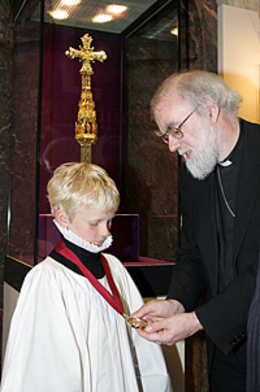Archbishop Attends Opening of Goldsmiths' Exhibition
 Archbishop & Joseph, St Paul's Goldsmiths' Chorister, at the Goldsmiths' Exhibition
Archbishop & Joseph, St Paul's Goldsmiths' Chorister, at the Goldsmiths' ExhibitionThursday 29th May 2008
The Archbishop attended, as patron, the opening of the Goldsmiths' Summer Exhibition: Treasures of the English Church: Sacred Gold and Silver 800-2000.For more than 700 years, the Goldsmiths' Company has actively promoted and supported the crafts of goldsmithing, silversmithing and jewellery. This summer's exhibition features more than 330 spectacular objects from some of the grandest cathedrals and from parish churches throughout England.
Each piece vividly evokes the tradition, symbolism and unbroken ritual of the Church in England through the ages. Many of the treasures on display have until now only been seen by a local congregation.
The Archbishop is patron to the company and gave his views on the exhibition in an ITV London Tonight Interview. Click link on the right to listen to the Archbishp's comments [1Mb]
A transcript follows:
Dr Williams, a fairly facetious question to begin with really – do you feel any more confident about the financial stability in the Church of England now you've seen all of this?
I don't think it's got much to do with finance, I think it's got to do with beauty and the enrichment of worship.
Now, what do you think this exhibition tells us about the history of the Church?
It tells us that from the very start of the Church's life in this country it's been a patron of art and craft as well. We mustn't just think of art as painting - it's craft with actual stuff, it's the making of things, and it continues therefore to be a body that encourages the highest excellence in craft. I think the Goldsmiths' Company is very committed to keeping that going and I think it looks to us to continue that encouragement.
Now the thing about most art, particularly the most art that goes on show in museums or galleries is it's very much looked untouched but that's not true with these objects..
Not at all. What you're looking at here is actually material that is in regular use, practically all of it is part of the routine furniture of churches up and down the country, and cathedrals.
The Archbishop also wrote a foreword for the Goldsmiths' exhibition catalogue: Treasures of the English Church
Foreword
by
The Archbishop of Canterbury
I am delighted to be the patron of this groundbreaking exhibition. There has been no major exhibition devoted to English church plate since 1955, when Christie's mounted a display in collaboration with the Historic Churches Preservation Trust. But that display concentrated on domestic objects donated to the Church, whereas this brings together for the first time as wide a range as possible of material designed for ecclesiastical use, from the ninth century to the present day, and is focused on plate that is still in use for its original purpose.
The Church has never been completely easy about the possession of extravagant liturgical objects. The great twelfth-century debate between St Bernard of Clairvaux and Abbot Suger of St Denis in Paris sets out the arguments: do riches distract the mind from the simple demands of the gospel and the need to be radically at the service of the poor? Or does the exuberance of skill and imagination itself display the overflowing extravagance of divine love, addressing human poverty at another level?
There has never been a simple answer to these questions; but we can at least say that the thousand years of craftsmanship represented here testifies to the passion so many have felt to put the very best they could do at the service of God. Despite all we hear about 'decline' in the Church or the alienation of people from traditional liturgy, it is striking how the tradition persists of commissioning beautiful objects for the Church's worship, and how ready the best craftsmen and artists still are – in this as in other areas – to offer their gifts at the altar.
The material collected here also tells us a good deal about the ups and downs of church history. Style varies as the understanding of what is happening in worship changes: the pursuance of splendour as a vehicle for the sacramental presence of God in our midst gives way to a more sober post-Reformation idiom, seeking simple functional elegance for the gathering of believers at the Lord's Table; then restlessness about a functionalism that can become routine and prosaic produces in turn a reaction towards elaboration and intricacy, before the wheel goes round again towards simplicity.
Yet much of the plate in our churches is likely to be older than the actual buildings where it is housed; it is a mark of continuity as well as a sign of the shifts and reversals of history. This material symbolises so much about the story of Christian faith in this country – often surrounded by controversy and uncertainty, sometimes unclear about how it should value its own traditions, yet persisting stubbornly in worship and witness, challenging the society around to integrity and excellence in all things – and ultimately to the celebration of an endless generosity in creation and redemption.
+ Rowan Cantuar:
